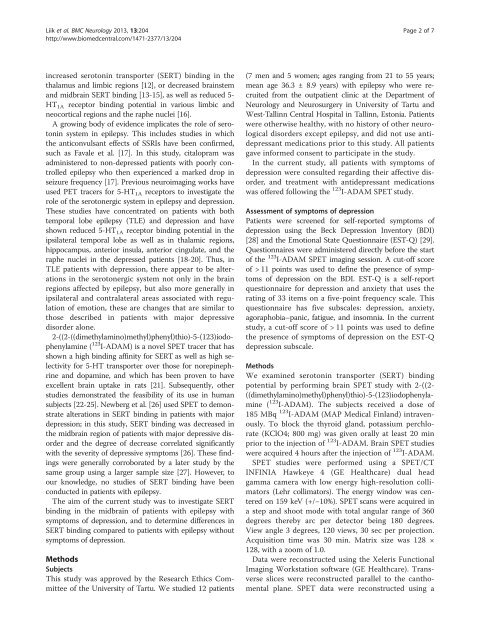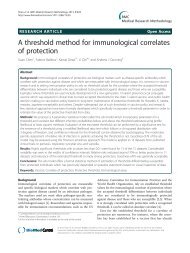I-ADAM SPET imaging of serotonin transporter in patients with ...
I-ADAM SPET imaging of serotonin transporter in patients with ...
I-ADAM SPET imaging of serotonin transporter in patients with ...
Create successful ePaper yourself
Turn your PDF publications into a flip-book with our unique Google optimized e-Paper software.
Liik et al. BMC Neurology 2013, 13:204 Page 2 <strong>of</strong> 7<br />
http://www.biomedcentral.com/1471-2377/13/204<br />
<strong>in</strong>creased <strong>seroton<strong>in</strong></strong> <strong>transporter</strong> (SERT) b<strong>in</strong>d<strong>in</strong>g <strong>in</strong> the<br />
thalamus and limbic regions [12], or decreased bra<strong>in</strong>stem<br />
and midbra<strong>in</strong> SERT b<strong>in</strong>d<strong>in</strong>g [13-15], as well as reduced 5-<br />
HT 1A receptor b<strong>in</strong>d<strong>in</strong>g potential <strong>in</strong> various limbic and<br />
neocortical regions and the raphe nuclei [16].<br />
A grow<strong>in</strong>g body <strong>of</strong> evidence implicates the role <strong>of</strong> <strong>seroton<strong>in</strong></strong><br />
system <strong>in</strong> epilepsy. This <strong>in</strong>cludes studies <strong>in</strong> which<br />
the anticonvulsant effects <strong>of</strong> SSRIs have been confirmed,<br />
such as Favale et al. [17]. In this study, citalopram was<br />
adm<strong>in</strong>istered to non-depressed <strong>patients</strong> <strong>with</strong> poorly controlled<br />
epilepsy who then experienced a marked drop <strong>in</strong><br />
seizure frequency [17]. Previous neuro<strong>imag<strong>in</strong>g</strong> works have<br />
used PET tracers for 5-HT 1A receptors to <strong>in</strong>vestigate the<br />
role <strong>of</strong> the serotonergic system <strong>in</strong> epilepsy and depression.<br />
These studies have concentrated on <strong>patients</strong> <strong>with</strong> both<br />
temporal lobe epilepsy (TLE) and depression and have<br />
shown reduced 5-HT 1A receptor b<strong>in</strong>d<strong>in</strong>g potential <strong>in</strong> the<br />
ipsilateral temporal lobe as well as <strong>in</strong> thalamic regions,<br />
hippocampus, anterior <strong>in</strong>sula, anterior c<strong>in</strong>gulate, and the<br />
raphe nuclei <strong>in</strong> the depressed <strong>patients</strong> [18-20]. Thus, <strong>in</strong><br />
TLE <strong>patients</strong> <strong>with</strong> depression, there appear to be alterations<br />
<strong>in</strong> the serotonergic system not only <strong>in</strong> the bra<strong>in</strong><br />
regions affected by epilepsy, but also more generally <strong>in</strong><br />
ipsilateral and contralateral areas associated <strong>with</strong> regulation<br />
<strong>of</strong> emotion, these are changes that are similar to<br />
those described <strong>in</strong> <strong>patients</strong> <strong>with</strong> major depressive<br />
disorder alone.<br />
2-((2-((dimethylam<strong>in</strong>o)methyl)phenyl)thio)-5-(123)iodophenylam<strong>in</strong>e<br />
( 123 I-<strong>ADAM</strong>) is a novel <strong>SPET</strong> tracer that has<br />
shown a high b<strong>in</strong>d<strong>in</strong>g aff<strong>in</strong>ity for SERT as well as high selectivity<br />
for 5-HT <strong>transporter</strong> over those for norep<strong>in</strong>ephr<strong>in</strong>e<br />
and dopam<strong>in</strong>e, and which has been proven to have<br />
excellent bra<strong>in</strong> uptake <strong>in</strong> rats [21]. Subsequently, other<br />
studies demonstrated the feasibility <strong>of</strong> its use <strong>in</strong> human<br />
subjects [22-25]. Newberg et al. [26] used <strong>SPET</strong> to demonstrate<br />
alterations <strong>in</strong> SERT b<strong>in</strong>d<strong>in</strong>g <strong>in</strong> <strong>patients</strong> <strong>with</strong> major<br />
depression; <strong>in</strong> this study, SERT b<strong>in</strong>d<strong>in</strong>g was decreased <strong>in</strong><br />
the midbra<strong>in</strong> region <strong>of</strong> <strong>patients</strong> <strong>with</strong> major depressive disorder<br />
and the degree <strong>of</strong> decrease correlated significantly<br />
<strong>with</strong> the severity <strong>of</strong> depressive symptoms [26]. These f<strong>in</strong>d<strong>in</strong>gs<br />
were generally corroborated by a later study by the<br />
same group us<strong>in</strong>g a larger sample size [27]. However, to<br />
our knowledge, no studies <strong>of</strong> SERT b<strong>in</strong>d<strong>in</strong>g have been<br />
conducted <strong>in</strong> <strong>patients</strong> <strong>with</strong> epilepsy.<br />
The aim <strong>of</strong> the current study was to <strong>in</strong>vestigate SERT<br />
b<strong>in</strong>d<strong>in</strong>g <strong>in</strong> the midbra<strong>in</strong> <strong>of</strong> <strong>patients</strong> <strong>with</strong> epilepsy <strong>with</strong><br />
symptoms <strong>of</strong> depression, and to determ<strong>in</strong>e differences <strong>in</strong><br />
SERT b<strong>in</strong>d<strong>in</strong>g compared to <strong>patients</strong> <strong>with</strong> epilepsy <strong>with</strong>out<br />
symptoms <strong>of</strong> depression.<br />
Methods<br />
Subjects<br />
This study was approved by the Research Ethics Committee<br />
<strong>of</strong> the University <strong>of</strong> Tartu. We studied 12 <strong>patients</strong><br />
(7 men and 5 women; ages rang<strong>in</strong>g from 21 to 55 years;<br />
mean age 36.3 ± 8.9 years) <strong>with</strong> epilepsy who were recruited<br />
from the outpatient cl<strong>in</strong>ic at the Department <strong>of</strong><br />
Neurology and Neurosurgery <strong>in</strong> University <strong>of</strong> Tartu and<br />
West-Tall<strong>in</strong>n Central Hospital <strong>in</strong> Tall<strong>in</strong>n, Estonia. Patients<br />
were otherwise healthy, <strong>with</strong> no history <strong>of</strong> other neurological<br />
disorders except epilepsy, and did not use antidepressant<br />
medications prior to this study. All <strong>patients</strong><br />
gave <strong>in</strong>formed consent to participate <strong>in</strong> the study.<br />
In the current study, all <strong>patients</strong> <strong>with</strong> symptoms <strong>of</strong><br />
depression were consulted regard<strong>in</strong>g their affective disorder,<br />
and treatment <strong>with</strong> antidepressant medications<br />
was <strong>of</strong>fered follow<strong>in</strong>g the 123 I-<strong>ADAM</strong> <strong>SPET</strong> study.<br />
Assessment <strong>of</strong> symptoms <strong>of</strong> depression<br />
Patients were screened for self-reported symptoms <strong>of</strong><br />
depression us<strong>in</strong>g the Beck Depression Inventory (BDI)<br />
[28] and the Emotional State Questionnaire (EST-Q) [29].<br />
Questionnaires were adm<strong>in</strong>istered directly before the start<br />
<strong>of</strong> the 123 I-<strong>ADAM</strong> <strong>SPET</strong> <strong>imag<strong>in</strong>g</strong> session. A cut-<strong>of</strong>f score<br />
<strong>of</strong> > 11 po<strong>in</strong>ts was used to def<strong>in</strong>e the presence <strong>of</strong> symptoms<br />
<strong>of</strong> depression on the BDI. EST-Q is a self-report<br />
questionnaire for depression and anxiety that uses the<br />
rat<strong>in</strong>g <strong>of</strong> 33 items on a five-po<strong>in</strong>t frequency scale. This<br />
questionnaire has five subscales: depression, anxiety,<br />
agoraphobia–panic, fatigue, and <strong>in</strong>somnia. In the current<br />
study, a cut-<strong>of</strong>f score <strong>of</strong> > 11 po<strong>in</strong>ts was used to def<strong>in</strong>e<br />
thepresence<strong>of</strong>symptoms<strong>of</strong>depressionontheEST-Q<br />
depression subscale.<br />
Methods<br />
We exam<strong>in</strong>ed <strong>seroton<strong>in</strong></strong> <strong>transporter</strong> (SERT) b<strong>in</strong>d<strong>in</strong>g<br />
potential by perform<strong>in</strong>g bra<strong>in</strong> <strong>SPET</strong> study <strong>with</strong> 2-((2-<br />
((dimethylam<strong>in</strong>o)methyl)phenyl)thio)-5-(123)iodophenylam<strong>in</strong>e<br />
( 123 I-<strong>ADAM</strong>). The subjects received a dose <strong>of</strong><br />
185 MBq 123 I-<strong>ADAM</strong> (MAP Medical F<strong>in</strong>land) <strong>in</strong>travenously.<br />
To block the thyroid gland, potassium perchlorate<br />
(KClO4; 800 mg) was given orally at least 20 m<strong>in</strong><br />
prior to the <strong>in</strong>jection <strong>of</strong> 123 I-<strong>ADAM</strong>. Bra<strong>in</strong> <strong>SPET</strong> studies<br />
were acquired 4 hours after the <strong>in</strong>jection <strong>of</strong> 123 I-<strong>ADAM</strong>.<br />
<strong>SPET</strong> studies were performed us<strong>in</strong>g a <strong>SPET</strong>/CT<br />
INFINIA Hawkeye 4 (GE Healthcare) dual head<br />
gamma camera <strong>with</strong> low energy high-resolution collimators<br />
(Lehr collimators). The energy w<strong>in</strong>dow was centered<br />
on 159 keV (+/−10%). <strong>SPET</strong> scans were acquired <strong>in</strong><br />
a step and shoot mode <strong>with</strong> total angular range <strong>of</strong> 360<br />
degrees thereby arc per detector be<strong>in</strong>g 180 degrees.<br />
View angle 3 degrees, 120 views, 30 sec per projection.<br />
Acquisition time was 30 m<strong>in</strong>. Matrix size was 128 ×<br />
128, <strong>with</strong> a zoom <strong>of</strong> 1.0.<br />
Data were reconstructed us<strong>in</strong>g the Xeleris Functional<br />
Imag<strong>in</strong>g Workstation s<strong>of</strong>tware (GE Healthcare). Transverse<br />
slices were reconstructed parallel to the canthomental<br />
plane. <strong>SPET</strong> data were reconstructed us<strong>in</strong>g a
















